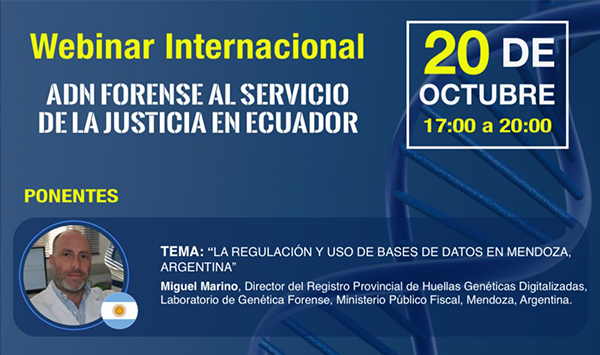Argentina: A bill to modify the National Registry of Genetic Data was presented in the Senate

The activity was led by the head of the JxC interbloc in the Senate, Alfredo Cornejo, who highlighted that “the genetic registry is indubitable proof”, and the deputy Juan Martín. The initiative, which is based on the Mendoza experience, seeks to «generate the largest possible genetic bank to legally suppress crimes.»
Argentina: Presentaron en el Senado un proyecto para la modificación del Registro Nacional de Datos Genéticos

La actividad fue encabezada por el jefe del interbloque JxC en el Senado, Alfredo Cornejo, quien destacó que “el registro genético es una prueba indubitable”; y el diputado Juan Martín. La iniciativa, que tiene como antecedente la experiencia mendocina, busca “generar un banco genético lo más amplio posible para reprimir legalmente los delitos”.
Justicia Forense – DNA Latin America is supporting the Ecuadorian State

Justicia Forense – DNA Latin America is supporting the Ecuadorian state in a Webinar on the future of forensic DNA in the Ecuadorian justice system. Join us! October 20
Justicia Forense – ADN Latinoamérica está apoyando al Estado Ecuatoriano

Justicia Forense – ADN Latinoamérica está apoyando al estado Ecuatoriano en un Webinar sobre el futuro del ADN forense en el sistema de justicia del Ecuador. ¡Únanse! 20 de octubre
A genetic bank to end impunity in Colombia

Suspects and convicted persons will be included in this database, which is already in operation in the country, although with several gaps, which the Attorney General’s Office wants to resolve with a bill. It also seeks to create another ambitious system to identify Colombians using DNA instead of fingerprints.
Un banco genético para acabar con la impunidad en Colombia

Desde sospechosos hasta condenados serán incluidos en esta base de datos que ya funciona en el país, aunque con varios vacíos, que la Fiscalía quiere resolver con un proyecto de ley. Además busca crear otro ambicioso sistema para identificar a los colombianos con el ADN en lugar de la huella dactilar.









 EL SALVADOR
EL SALVADOR HONDURAS
HONDURAS

 BOLIVIA
BOLIVIA PERÚ
PERÚ